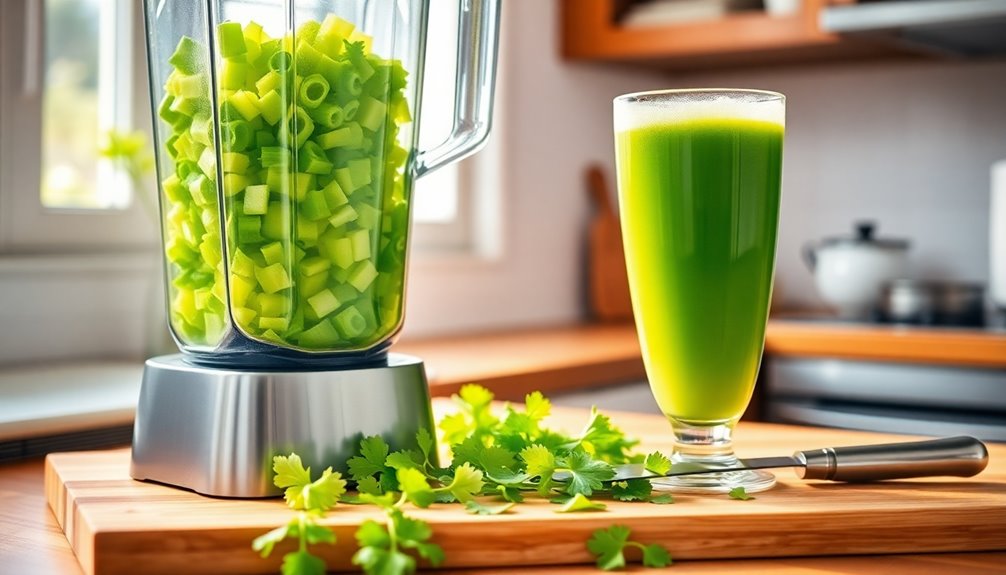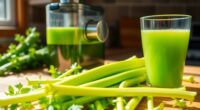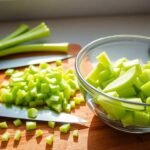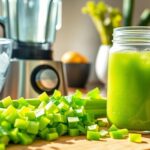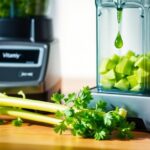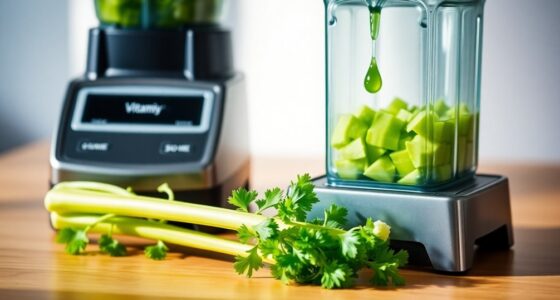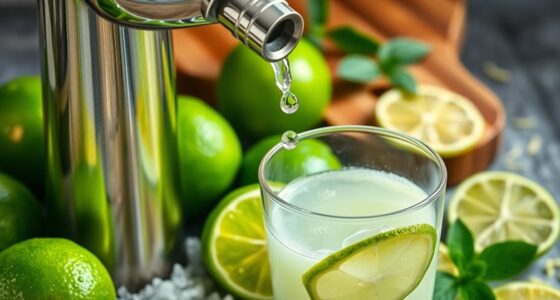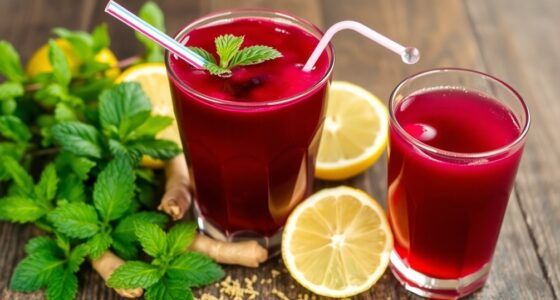To make celery juice in a blender, start by washing a full head of fresh celery thoroughly. Chop it into smaller pieces, then blend the chopped celery with 1/2 cup of spring water on high until fully liquefied. Use a nut milk bag or fine mesh sieve to strain the juice, extracting the liquid while leaving the pulp behind. Serve it immediately over ice, and feel free to add lemon juice or fruits for extra flavor. There’s more to learn about serving and variations! For those interested in how to prepare celery juice, consider experimenting with different flavor combinations by incorporating ingredients like apple or ginger for a refreshing twist. You can also store any leftover juice in the refrigerator for up to 24 hours, but it’s best enjoyed fresh for optimal taste and nutrition. Don’t forget to explore additional variations, such as adding greens or herbs for an extra health boost!
Key Takeaways
- Wash a full head of fresh celery thoroughly to remove any dirt and pesticides before preparation.
- Chop the celery into smaller pieces to facilitate blending in the blender.
- Combine the chopped celery with 1/2 cup of spring water in the blender and blend on high until liquefied.
- Strain the blended mixture using a nut milk bag or fine mesh sieve to separate the juice from the pulp.
- Serve the juice immediately over ice, optionally adding fresh lemon juice or fruits for enhanced flavor.
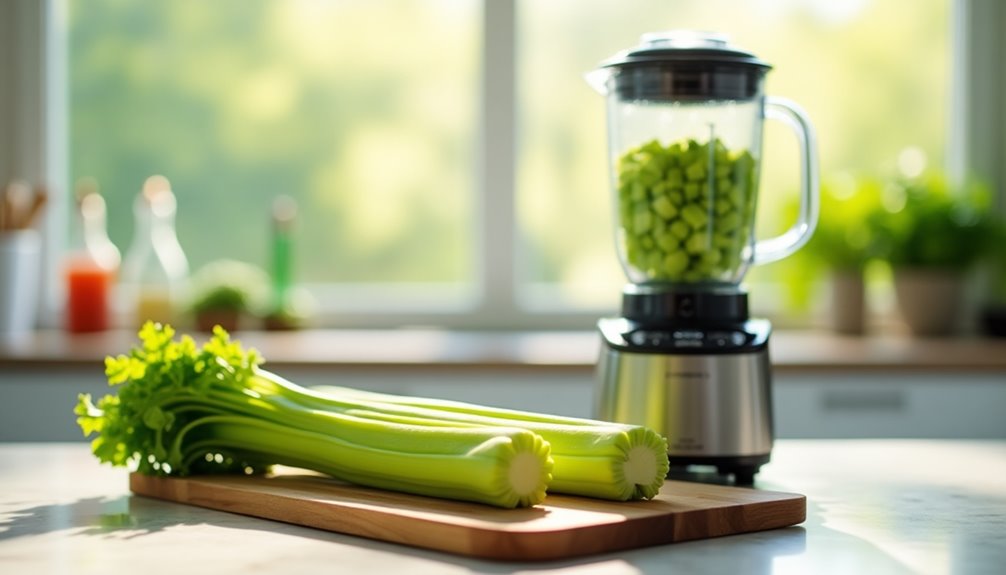
Making your own celery juice in a blender is quick and rewarding. If you're looking for a refreshing and nutritious drink, you're in the right place. Drinking celery juice first thing in the morning can set a positive tone for your day. Packed with celery juice benefits, this drink isn't only hydrating but also rich in Vitamin K, which supports bone health and helps with blood clotting. Plus, it's a fantastic way to incorporate more greens into your diet.
To start, grab a full head of fresh celery. Wash it thoroughly to remove any dirt or pesticides. Once cleaned, chop the celery into smaller pieces. This will make it easier for your high power blender to break it down.
Next, add the chopped celery into your blender along with about 1/2 cup of spring water. This small amount of water helps the blending process and ensures you get a smooth, juice-like consistency. Now, you're ready to blend on high. The goal is to pulverize the celery until it's fully liquefied, which should only take a minute or two.
Once you've achieved that smooth texture, it's time to strain out the pulp. For this step, you'll need a nut milk bag or a fine mesh sieve. Place the bag or sieve over a bowl or pitcher, pour the blended celery mixture into it, and gently squeeze. This allows the juice to flow through while leaving the pulp behind. You can save that pulp for later; it works great in smoothies or can even be composted.
If you want to elevate your celery juice recipe, consider adding a splash of fresh lemon juice for a zesty kick. You can also blend in other fruits like green apples or ginger to enhance the flavor and nutritional profile. This way, you're not only enjoying the health benefits of celery but also a delicious drink that suits your taste.
Once you've strained the juice, serve it immediately over ice. The freshness of your homemade celery juice will be apparent with every sip, and it's perfect as a morning refresher. Plus, it's an excellent addition to your collection of healthy recipes.
You may find that drinking celery juice regularly helps with digestion and boosts your overall wellness.
Frequently Asked Questions
Can You Blend Celery Instead of Juicing?
Yes, you can definitely blend celery instead of juicing it!
When you blend, you retain more fiber and nutrients, which is a big plus. You'll create a juice-like consistency by adding water, and if you want a smoother texture, just strain it through a nut milk bag.
Plus, blending generates less waste since you use the entire stalk. If you prefer a chewier drink, blending is a fantastic option!
How Do You Liquify Celery in a Blender?
Imagine you're in a futuristic kitchen, blending ingredients like a pro.
To liquify celery in a blender, start by washing and roughly chopping a head of celery into smaller pieces.
Add about 1/2 cup of spring water to help achieve that juice-like consistency.
Blend on high speed for 30 seconds to a minute until smooth.
For an ultra-smooth result, strain the mixture with a nut milk bag or fine mesh sieve.
Enjoy!
What Not to Mix With Celery Juice?
When you're enjoying celery juice, it's best to avoid mixing it with high-sugar fruits like bananas or grapes, which can spike your blood sugar.
Steer clear of dairy products, as they might cause digestive discomfort.
Also, don't combine it with acidic ingredients like orange juice, as it disrupts the juice's benefits.
Lastly, skip adding caffeine sources or processed foods, since they can negate the hydrating and detoxifying effects of celery juice.
What Does Drinking Celery Juice Every Day Do for You?
Drinking celery juice every day can work wonders for your health.
You'll likely notice improved digestion and reduced issues like constipation or acid reflux. It helps detoxify your body, flush out toxins, and fights inflammation thanks to its antioxidants.
Plus, you'll get a significant boost of nutrients, including Vitamin K. Many people also report clearer skin and enhanced mental clarity, making it a great addition to your morning routine.
Conclusion
In conclusion, making celery juice in a blender is quick and easy, giving you a refreshing drink packed with nutrients. Did you know that just one cup of celery juice contains over 40 different types of antioxidants? By incorporating this vibrant beverage into your daily routine, you're not only enhancing your hydration but also boosting your overall health. So why not give it a try? Your body will thank you!
Cindy thoroughly researches juicing trends, techniques, and recipes to provide readers with practical advice and inspiration. Her writing style is accessible, engaging, and designed to make complex concepts easy to understand. Cindy’s dedication to promoting the advantages of juicing shines through her work, empowering readers to make positive changes in their lives through the simple act of juicing.

